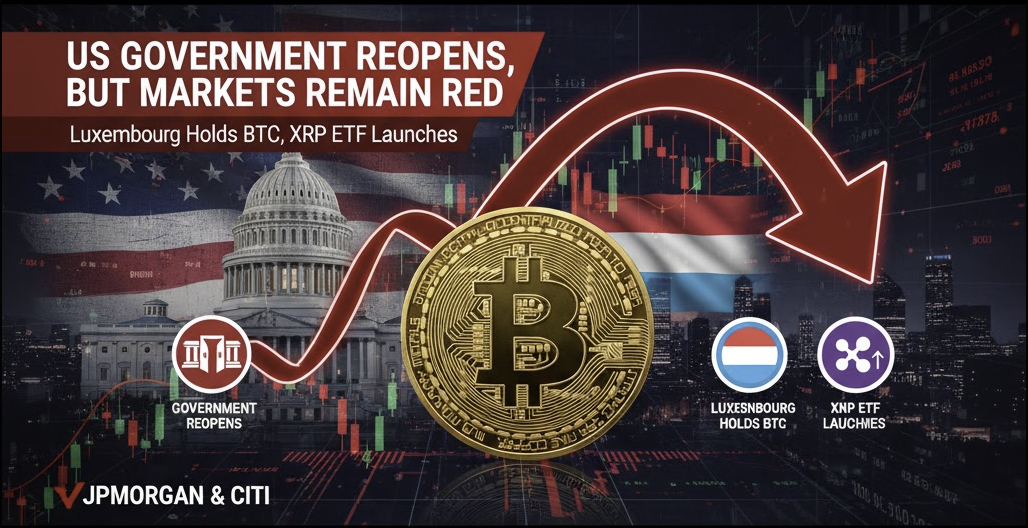The US Congress has passed President Trump's substantial spending bill, signaling continued government expenditure and monetary expansion. This development is impacting market sentiment, while assets like stocks and Bitcoin continue their upward trajectory. Meanwhile, Bitcoin's recent growth shows a remarkable correlation with the surge in M2 money supply, highlighting the influence of liquidity on its performance.
Market Overview
US equities closed higher across all three major indices on Thursday, July 3rd, with the Nasdaq leading gains at 1.02%. Oil futures rose to $67.13 per barrel. Gold remained stable at $3340 per ounce.

Bitcoin hovered around $109,000. Most major altcoins showed slight declines. The overall crypto market capitalization stood at $3.44 trillion.

US Bitcoin spot ETFs had an exceptionally strong day on Thursday, recording total inflows of $601.8 million. ETH spot ETFs also saw significant inflows compared to previous sessions, totaling $148.5 million. These substantial inflows underscore robust institutional appetite for digital asset exposure.

Recent US employment reports present a mixed picture, making it challenging to accurately assess the labor market's health. Specifically, ADP reported a decrease of approximately 30,000 jobs last month, falling significantly short of analysts' expectations for a 90,000 increase. However, the official report from the US Department of Labor painted a brighter picture: non-farm payrolls increased by 147,000 during the month, surpassing the forecast of 111,000 and exceeding the previous period's 114,000. The unemployment rate also came in lower than predicted, at just 4.1% instead of 4.3%.
This positive employment data immediately pushed the yield on 10-year US government bonds higher, reflecting expectations that the Federal Reserve (Fed) will continue to hold interest rates steady, as there isn't a sufficiently strong reason for a cut. Following the better-than-expected employment data, financial markets adjusted their probability forecasts for rate cuts this year. For the July meeting, the probability of the Fed holding rates steady surged to 94.8%, with only 5.2% anticipating a cut. For September, approximately 63.8% of the market still expects a rate cut. Moving to October, the expectation for a second cut is 55.7%. However, by December, the probability for a third cut has sharply decreased, with only 46.1% now leaning towards the possibility of maintaining rates after two cuts. Thus, instead of three rate cuts as previously anticipated, the market is now leaning towards a scenario where the Fed will only implement two rate cuts in 2025.
US House Passes Massive Trump Spending Bill Amidst Political Divide
After hours of intense debate and prolonged discussion, the US House of Representatives narrowly passed President Donald Trump's significant spending bill with a vote of 218–214. This marks the final legislative step before the bill is presented to the President for his signature, meeting the deadline before the July 4th Independence Day holiday.

The Senate had previously approved this bill. In the House, two Republican representatives, Thomas Massie and Brian Fitzpatrick, voted against it, alongside the entire Democratic caucus. Democratic leader Hakeem Jeffries delivered a nearly 9-hour speech criticizing the bill before the vote. This bill has also caused significant division within both parties.
The bill, informally dubbed "One Big, Beautiful Bill," includes trillions of dollars in tax cuts and increased spending for immigration enforcement programs. Concurrently, the bill reduces funding for Medicaid (a public health program for low-income individuals) and several other social programs. The Congressional Budget Office (CBO) warned that this bill could add an additional $3.4 trillion to the US national debt over the next decade. However, the White House argues that the CBO's estimates are biased and do not fully reflect the long-term benefits of the plan.
Ray Dalio's Warning: Soaring National Debt and its Implications
According to veteran investor Ray Dalio, now that the budget bill has been officially passed by the US Congress, the full picture of budget deficits, government debt, and debt servicing costs has become clearer than ever.

This bill will lead to approximately $7 trillion in annual spending, while government revenue is only around $5 trillion. The current national debt is equivalent to about 600% of the government's annual revenue, or 100% of GDP, meaning each US household bears about $230,000 in debt. Within the next 10 years, this figure is projected to increase to 7.5 times the government's annual income, equivalent to 130% of GDP, and an average of $425,000 in debt per household. Debt servicing costs, including principal and interest, are predicted to rise from $10 trillion to $18 trillion, with interest alone accounting for $2 trillion, double the current level.
Dalio believes that to cope with this situation, the US government may be forced to choose drastic measures such as significant spending cuts, aggressive tax increases, printing more money (leading to dollar devaluation), or pushing interest rates to extremely low levels. However, the likelihood of tax increases and spending cuts is low because the administration will want to keep the public happy for the upcoming elections. A more probable scenario involves money printing and interest rate reductions. However, this will devalue the dollar, severely harming holders of government bonds and threatening the stability of the entire financial system, as US Treasury bonds are considered the foundation of global capital markets.
Dalio warns that if the budget deficit—currently around 7% of GDP—is not reduced to near 3% through adjustments in spending, taxes, and monetary policy, the risk of significant and painful disruptions to the economy is entirely possible. This stark warning from a highly respected investor underscores the potential for macroeconomic shifts that could further fuel the appeal of decentralized, scarce assets like Bitcoin.
Bitcoin OTC Supply Hits Record Low as Institutions Accumulate
Data from CryptoQuant reveals that Bitcoin supply at over-the-counter (OTC) desks—where large, discreet transactions are processed—has plummeted to a record low. Since January, the amount of BTC held in OTC wallets linked to mining pools has decreased by 21%, now standing at only approximately 155,472 BTC, equivalent to $17.1 billion. This data excludes Bitcoin stored on exchanges or held by individual miners, indicating that the actual supply available for OTC transactions is increasingly scarce. This development could create upward price pressure amid rising demand.

In fact, June saw a significant expansion of institutional participation in the Bitcoin market. Twenty-one new companies began holding a total of 6,745 BTC, while 42 existing companies increased their holdings by a combined 61,309 BTC. Concurrently, 47 other companies are planning multi-billion dollar Bitcoin purchases, and 43 entities are raising capital to further expand their positions. Additionally, 22 companies have officially disclosed their Bitcoin holdings and provided detailed updates. These figures indicate a strong capital shift from institutions and reinforce a long-term accumulation trend as supply increasingly tightens.

The reduction in Bitcoin at OTC desks combined with increased accumulation by numerous large companies points to a strong institutional accumulation trend. This reduces market supply, creating upward price pressure in the future. With large capital inflows and growing participation, the Bitcoin market is in a sustainable growth phase, while also requiring investors to monitor closely for appropriate strategies. This phenomenon underscores Bitcoin's maturation from a niche asset to a recognized store of value and a strategic asset for corporations.
Other Key Crypto & Financial Updates
Senator Lummis recently proposed a new digital asset tax bill to be included in the Omnibus Budget Reconciliation Bill (OBBB). This bill proposes tax exemptions for small personal transactions under $300, ends double taxation on mining and staking activities, and creates tax fairness for lending, wash sales, and mark-to-market—similar to stocks. Additionally, crypto donations would not require asset valuation. This comprehensive tax reform aims to provide much-needed clarity and fairness for digital asset holders.
Tether minted an additional 1 billion USDT on the Ethereum network on Thursday (US time). This continuous minting indicates robust demand for stablecoins, often used as liquidity in the crypto market.
Tom Lee, Chairman of Fundstrat Global Advisors, remarked that Bitcoin ETFs are the most successful product launch in history, yet BTC's price has only seen modest gains because many existing BTC holders are transferring their assets into ETFs rather than new money entering the market. Additionally, many early investors are taking profits at higher prices. Currently, 95% of large institutions still haven't bought in, indicating that the market is gradually shifting from early profit-takers to new institutional investors.
Tom Lee, Chairman of Bitmine (note: this appears to be a typo and likely refers to Fundstrat's Tom Lee or another related entity, as Bitmine is a different company), stated that his company has raised $250 million to acquire and hold Ethereum, akin to MicroStrategy's strategy with Bitcoin. He believes that traditional finance and crypto will rapidly converge in 2025, with stablecoins playing a central role. Ethereum is the primary platform for stablecoins, helping ensure security and regulatory compliance, thus staking ETH both secures the network and generates economic benefits. Lee expects stablecoin market capitalization to surge, bringing significant value to Ethereum. This highlights the growing institutional interest in Ethereum as an infrastructure play within the digital asset ecosystem.
In June 2025, spot trading volume on centralized exchanges (CEX) decreased to $1.07 trillion, its lowest level since September 2024. Meanwhile, decentralized exchanges (DEX) achieved a record $390 billion in spot trading volume, pushing the DEX/CEX ratio to an all-time high of 29%. The DEX derivatives trading ratio compared to CEX also reached a record 8%. This trend signifies a notable shift towards decentralized trading platforms, reflecting growing user preference for decentralized alternatives and the increasing maturity of the DeFi sector.
Sources
- Bloomberg
- CoinDesk
- U.S. Treasury
- TradingView
- Reuters
- SEC
- ADP Employment Report
- US Department of Labor
- Congressional Budget Office (CBO)
- Ray Dalio (Bridgewater Associates)
- CryptoQuant
- Senator Cynthia Lummis's Office
- Tether
- Tom Lee (Fundstrat Global Advisors)
Disclaimer
This article is for informational purposes only and should not be considered financial advice. Please do your own research before making investment decisions.


.png)





